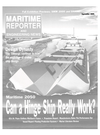
Ties that bind
Nearly a quarter-century on from landing an order for what proved to be one of the industry's most remarkable series of RoRo vessels, the Hyundai yard has struck a new deal with the Stena organization for RoPax tonnage. The 11 Searunner-class vessels commissioned out of Ulsan between 1977 and 1979 denoted a farsighted investment by the Swedish group. The entire series found ready employ in various European trades, and the flexibility of the design resulted in a range of subsequent enlargement and conversion schemes, which kept the vessels to the fore in various fields for many years. While the Searunner breed provided the South Korean shipbuilder with an impressive, early reference in the RoRo domain, the latest contract award also has strategic significance for Hyundai in taking the yard into the buoyant RoPax sector. The order from Stena RoRo initially entails a vessel of some 2.400 lane-meters of RoRo capacity and incorporating accommodation for 900 passengers, due to be handed over in 2002. The agreement includes an option on a second-of-class. Stena is currently also sourcing RoRo tonnage in China, in the shape of a 12.300-dwt series from Dalian Shipyard. But the group's business links with Hyundai Heavy Industries are manifested not only in the new RoPax but also in a pair of innovative crude carriers under construction for the associated company Concordia Maritime. The V-Max class of twin-skeg, 314,500-dwt tankers is characterized by an exceptionally wide beam and shallow draft. It emphasizes the Swedish group's propensity for innovation and again demonstrates the South Korean yard's position in the vanguard of new ship design and engineering developments.
— David Tinslex
Other stories from September 2000 issue
Content
- Millennium Slated For NNS Visit page: 44A
- PBCF Aids Propulsion Efficiency page: 44A
- First Of Modified Destroyers Commissioned page: 44B
- Ties that bind page: 44B
- First Family of Design page: 8
- Unitor Launches New IT Program page: 13
- Market Forces And Technology Will Shape The Futre Of Shipping page: 17
- Bahamas Receives New RoPax Service page: 23
- Crowley Delivers Last Of Prevention Tug Series page: 23
- Image Marine Delivers Police Boat Trio page: 24
- PTC Launches New CAD/CAM Shipbuilding Solution page: 25
- SNAME 2000 Aims To Connect Leaders page: 28
- Pods for a rising market page: 31
- NNS Fixes Circle 278 on Reader Service Card ISO 9001 CERTIFIED 8365 Highway 308 South • Lockport, Louisiana 70374 Telephone: (504) 532-2554 • Fax: (504) 532-7225 • www.bollingershipyards.com Paradise s Pod page: 32
- MTU Enters The Medium Speed Fray With The 8000 page: 34
- U.S. Footprint In Germany page: 34
- Ship Noise Guide Updated page: 38
- Can the Hinge Ship Work? page: 40
- The Many Modes of Hinge-Ship page: 42
- Welcome "Lo Jack" For Ships page: 44
- lnternet@Sea page: 44
- The more things change... page: 45
- SMM 2000 Set For Hamburg page: 47
- Omnithruster Continues To "Lead The Way" page: 52
- FPSO Retrofit Design Accelerated With CAD page: 54
- Ballast Water Management & Treatment Take Center Stage page: 67

